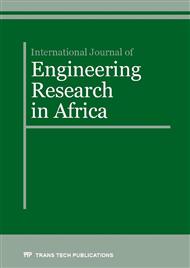[1]
Alsac. O and B. Scott, (1973) Optimal load flow with steady state security, , IEEE Transaction. PAS , pp.745-751.
Google Scholar
[2]
Lee K. Y , Paru Y. M, Oritz J. L, (1985) A united approach to optimal real and reactive power dispatch, , IEEE Transactions on power Apparatus and systems, PAS-104 : 1147-1153.
DOI: 10.1109/tpas.1985.323466
Google Scholar
[3]
Monticelli. A,M.V. F Pereira , and S. Granville, (1987) Security constrained optimal power flow with post contingency corrective rescheduling, , IEEE Transactions on Power Systems, PWRS-2, No. 1, pp.175-182.
DOI: 10.1109/tpwrs.1987.4335095
Google Scholar
[4]
Deeb. N , ShahidehpurS. M, (1990) Linear reactive power optimization in a large power network using the decomposition approach, , IEEE Transactions on power system, 5(2) : 428-435.
DOI: 10.1109/59.54549
Google Scholar
[5]
Hobson. E, (1980), Network consrained reactive power control using linear programming, , IEEE Transactions on power systems PAS -99 (4) , pp.868-877.
DOI: 10.1109/tpas.1980.319715
Google Scholar
[6]
Lee .K. Y ,Y. M Park , and J. L Oritz, (1993) Fuel –cost optimization for both real and reactive power dispatches, , IEE Proc; 131C, (3), pp.85-93.
Google Scholar
[7]
Mangoli.M. K and K.Y. Lee, (1993), Optimal real and reactive power control using linear programming, , Electrical Power System Research , Vol. 26, pp.1-10.
DOI: 10.1016/0378-7796(93)90063-k
Google Scholar
[8]
Canizares.C. A,A.C.Z. de Souza and V.H. Quintana , (1996) Comparison of performance indices for detection of proximity to voltage collapse', , vol. 11. no. 3, pp.1441-1450.
DOI: 10.1109/59.535685
Google Scholar
[9]
Berizzi.C. Bovo,M. Merlo, andM. Delfanti, (2012), A ga approach to compare orpf objective functions including secondary voltage regulation, , Electric Power Systems Research, vol. 84, no. 1, p.187 – 194.
DOI: 10.1016/j.epsr.2011.11.014
Google Scholar
[10]
Roy. P,S. Ghoshal, andS. Thakur, (2012).
Google Scholar
[11]
Hu. Z,X. Wang, andG. Taylor, (2010), Stochastic optimal reactive power dispatch: Formulation and solution method, International Journal of Electrical Power and Energy Systems, vol. 32, no. 6, p.615 – 621.
DOI: 10.1016/j.ijepes.2009.11.018
Google Scholar
[12]
Eleftherios, Amoiralis, Pavlos, Georgilakis, Marina, Antonios Kladas, (2010) Ant Colony Optimisation solution to distribution transformer planning problem, Internationl Journal of Advanced Intelligence Paradigms , Vol. 2, No. 4, p.316 – 335.
DOI: 10.1504/ijaip.2010.036398
Google Scholar
[13]
Berkopec . A (2012), Fast Particles as Initiators of Stepped Leaders in CG and IC Lightnings, Journal of Electrostat, vol. 70, p.462–467.
DOI: 10.1016/j.elstat.2012.07.001
Google Scholar
[14]
Tizhoosh.H. R (2005) Opposition-Based Learning: A New Scheme for Machine Intelligence, CIMCA/IAWTIC. p.695–701.
Google Scholar
[15]
Wu.Q. H, Cao.Y. J and Wen.J. Y (1998), Optimal reactive power dispatch using an adaptive genetic algorithm, Int.J. Elect. Power Energy Syst. Vol 20. Pp. 563-569.
DOI: 10.1016/s0142-0615(98)00016-7
Google Scholar
[16]
Zhao. B, Guo.C. X and Cao.Y. J (2005), Multiagent-based particle swarm optimization approach for optimal reactive power dispatch, IEEE Trans. Power Syst. Vol. 20, no. 2, pp.1070-1078.
DOI: 10.1109/tpwrs.2005.846064
Google Scholar
[17]
Mahadevan. K , Kannan.P. S (2010), Comprehensive Learning Particle Swarm Optimization for Reactive Power Dispatch, , Applied Soft Computing, Vol. 10, No. 2, p.641–52.
DOI: 10.1016/j.asoc.2009.08.038
Google Scholar
[18]
Khazali.A. H, Kalantar . M (2011), Optimal Reactive Power Dispatch based on Harmony Search Algorithm, , Electrical Power and Energy Systems, Vol. 33, No. 3, p.684–692.
DOI: 10.1016/j.ijepes.2010.11.018
Google Scholar
[19]
Sakthivel. S,M. Gayathri,V. Manimozhi, (2013), A Nature Inspired Optimization Algorithm for Reactive Power Control in a Power System, , International Journal of Recent Technology and Engineering, pp.29-33, Vol. 2, Issue-1.
Google Scholar
[20]
Chaohua Dai, Weirong Chen, Yunfang Zhu, and Xuexia Zhang, Seeker optimization algorithm for optimal reactive power dispatch, , IEEE Trans. Power Systems, Vol. 24, No. 3, August 2009, pp.1218-1231.
DOI: 10.1109/tpwrs.2009.2021226
Google Scholar
[21]
J. R. Gomes and 0. R. Saavedra, Optimal reactive power dispatch using evolutionary computation: Extended algorithms, IEE Proc. -Gener. Transm. Distrib. Vol. 146, No. 6. Nov. (1999).
DOI: 10.1049/ip-gtd:19990683
Google Scholar
[22]
IEEE, The IEEE 30-bus test system and the IEEE 118-test system, , (1993), http: /www. ee. washington. edu/trsearch/pstca.
Google Scholar
[23]
Jiangtao Cao, Fuli Wang and Ping Li, An Improved Biogeography-based Optimization Algorithm for Optimal Reactive Power Flow, International Journal of Control and Automation Vol. 7, No. 3 (2014), pp.161-176.
DOI: 10.14257/ijca.2014.7.3.16
Google Scholar


